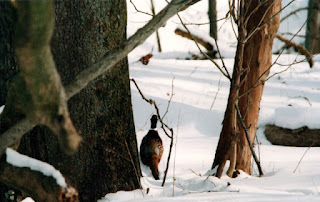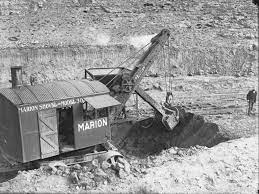by Randy Lawrence
Over top they shrugged into brown duck hunting coats and vests like the ones men, and sometimes even women, wore in the Field and Stream magazines Grandpa kept in a stack by his overstuffed living room chair. To a man, they sported dingy red ball caps or ear flapped, red plaid Stromy Kromers, their sole concession to safety color.
The impossibly long guns they pulled from the trunks of their family cars - nobody in my family had a pickup truck back then - were all repeaters, pumps mostly, and I can still see our menfolk cramming red or green or yellow shells in spring-worn magazines, the clacking racking sound of closing actions loud enough for me to hear over the kitchen bustle behind me. They talked and laughed in puffs of white steam and cigarette smoke while Grandpa's farm dog, Rover Deeds, all wriggle and wag, moiled around their legs.
Rover Deeds was a beagle-collie mongrel named after an erstwhile beau of my mother's from years ago. Grandpa insisted that while Rover Deeds would run rabbits, what the dog loved most was to chase pheasants, the trophy of these annual Christmas Day hunts.
My Uncle Ronnie liked to claim Rover Deeds would even point pheasants "like a real bird dog." If he did, nobody else ever saw him do it.
My grandfather and his brothers all had town jobs, several of them alongside Grandpa at the foundry in town. During the Second War, they had worked years without a day off, 12 hour shifts and overtime, back when overtime was only half pay. When the winter weather was bad, they stayed in town for days at a time, which meant it was up to their wives and children to keep a house with no running water and tend sheep, cattle, and hogs until someone could get a tractor and plow county roads.
(The Marion Power Shovel Company where my grandfather worked for so many years building excavation machinery.)
But those backbreaking, lung fouling hours shoveling coal into furnaces to make steel to build the big steam shovels was a means to an end - a steady paycheck that propped up what they really wanted most to do: farm the land.
I don't know that any of them ever owned his own place, but my grandfather and his brothers were never happier than when they were working their rented ground or raising swoop-horned, half-wild Hereford cattle they bought cheap off the boxcars in from the western states. Their saggy, woven wire fencerows studded with Osage Orange fenceposts were rough and wide. Sheep pastured in small woodlots that were never overgrazed. Cranky antique combines and corn pickers proved indifferent about making a clean harvest of grains coaxed out of poor soil.
An unintended consequence of those hardscrabble farming practices was the creation of nearly ideal cover and feed for cottontail rabbits and ringneck pheasants...and after farming, the thing my grandfather and his kin loved best was hunting rabbits and pheasants. The one time they for sure could get out with the gun was Christmas morning before the big dinner, before the afternoon gift exchange in Grandma's crowded living room.
Once the hunt was out of sight from the kitchen door, I could scramble up the wooden steps to a freezing upstairs bedroom and watch much of the action from a bedroom window. Our men walked up game in a line, Rover Deeds not so much quartering as just dinking around and snuffling a few dozen yards ahead. At least twice I got to see the big dog start a rabbit, sparking a fusillade that echoed off the slumping barn and machinery sheds. Only once did I actually witness pheasants come up in front of the guns, only to batter away toward a far tree line while the skirmish line stuttered to a halt. Some of the guys reloaded, shaking their heads, and I could well imagine the grief they were getting from the others.
But they didn't always miss, especially my Uncle Earl and Grandma's brother George. There were always rabbits to clean in my grandparents' mud room, and if I stayed back and didn't ask too many questions, I could watch Grandpa or Uncle LeMoyne make deft cuts across the rabbits' stiff backs with their pocketknives, blades ground away to thin slices of steel, pulling fur to reveal red meat pressed against bluish skin membrane. I am sure I recoiled at steaming entrails tumbling down into a galvanized bucket for a later trip to the hog lot, but I hung in, desperate to be some small part of the hunting I knew I would love if ever I had the chance to go.
For me, the most wondrous of Christmases were when the the men came into the mudroom to pull pheasants, gaudy as bright holiday wrapping paper, from game pockets of those stiff canvas jackets. We kids were in awe of the big birds and clamored for tail feathers we could parade back into the warm kitchen or use like swords in mock duels until somebody's mom evicted us from the flurry of last minute dinner prep. I do not remember anyone dressing those pheasants on Christmas morn, instead drawing and hanging them to age for a couple of days until my grandmother could pluck them in time for a special New Year's Day meal.
(Leigh Yawkey Woodson Art Museum: "Birds In Art")
My grandfather died the year before I bought my first English setter, four years before we hunted our first Elhew pointer, more than three decades before the first Firelight setter came to live with me. He never got to hear about our trips to the Dakotas and Iowa, about ringnecks posed like Christmas ornaments in bare trees, about the golden eagle we once watched stoop on a snow plastered copse, scattering pheasants in all directions. I did not get to tell him about the piebald bird that cackled up in a spray of snow, pinned by a hoary-coated old setter, two of his get locked down to honor his last stand of one freezing New Year's Eve, or how warm and full the game pocket of my own canvas vest was on the long walk back to the truck.
That pheasant is one of only two pieces of taxidermy I own. This time of year, I can see the glow of my front porch Christmas lights on his window perch. He is anchored in flight off a chunk of Osage Orange, much like the pile posts he flushed from in the late afternoon gloaming. I doze in the shadow of that holiday bird, my Luke or Deacon or our buddy Seth clambering up to wedge in with me in the easy chair.
I can pet a silky, chiseled setter head and conjure the aroma of turkey and sage in my grandmother's crowded dining room, my mind's eye watching the adults find their seats around the long table the older kids had stretched with pegged wooden leaves and covered with tablecloths embroidered with mistletoe and Christmas wreath patterns. I can still see my cousins and me parked at a couple of card tables off to one side, our pheasant tail feathers confiscated, our plates made for us by our moms. That's about when Grandma would glare us into silence so Uncle George could give thanks on Christmas Day, the most magical of which always began with pheasants.










No comments:
Post a Comment